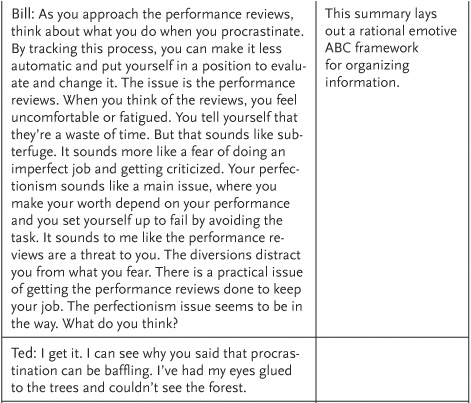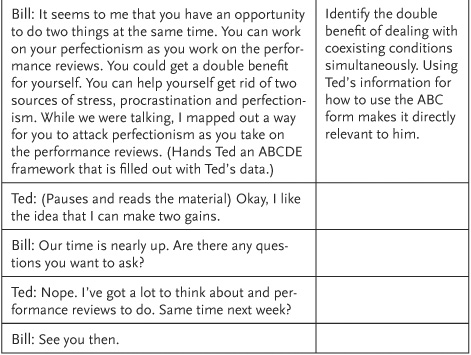End Procrastination Now! (27 page)
Read End Procrastination Now! Online
Authors: William D. Knaus



The therapy session fleshes out issues that you may find helpful when you are working with a client whose presenting problem is procrastination. The transcript uniquely shows how to separate and deal with both procrastination and coexisting conditions. But, as you may suspect, Ted still had a great deal of work remaining to get past his procrastination barrier.
If Ted completed the performance reviews, what was next? For some people, completing a delayed task means that there is one less thing to do. In Ted's case, finishing the reviews had an additional implication.
Ted experienced an
evaluation anxiety
. He feared that his staff would have bad reactions to his reviews. Not wanting to make a mistake, and having a strong need to be liked, Ted felt uncomfortable discussing performance problems with the members of his staff. That contributed to his procrastination.
By avoiding the reviews, Ted avoided telling other people what he thought they might not like to hear. He also feared that he would not achieve his fantasy goal: to make the reviews so meaningful that he'd be exalted. So Ted's procrastination was partially connected to anxious anticipations.
The dreaded performance discussions were on a time dimension. Ted had time to prepare. But his preparation was to avoid rather than to cope. His preparation involved fantasies about perfection. Then he delayed seeking the level of perfection that he suspected he could not attain. And if perfection was a contingency for action, and perfection was impossible, then procrastination was a predictable outcome.
The law of parsimony says that the simplest explanation is preferable to a more complicated one. A simple explanation is that Ted felt discomfort when he anticipated doing the performance
reviews, then ducked this discomfort by sidetracking himself into less pressing pursuits. However, you can practically always find complications that weave through a problem process. Bringing them up and dealing with them may be the most direct route out of a mental jungle filled with diversionary dead-end pathways.
Ted's perceptions of the performance reviews included a combination of a discomfort dodging, perfectionism, and procrastination in which each amplified the others. Ted's goal was to stop getting into hot water over his procrastination and to keep his job. His do-it-now solution was to attack procrastination and perfectionism at cognitive, emotional, and behavioral levels. As a by-product, he anticipated boosting his tolerance for his discomfort about the performance reviews.
Ted broke his complex procrastination habit into three challenges: (1) address his tendency to expect perfection from himself and make his worth depend on others' approval of his performances, (2) overcome his tendency to sidetrack himself when he felt uncomfortable about a timely task, and (3) behaviorally pursue the performance goals by refusing to divert himself.
â¢
Meeting the first challenge.
Ted seemed to enjoy resolving paradoxes. (1) He considered that John was okay even without 100 percent approval, so why should he treat himself differently? (2) He explored why he was able to accept that he could not turn 100 percent of his sales calls into sales, but he felt that he should please 100 percent of the sales staff with perfect performance reviews. Examining two potential contradictions showed a shift from a self-absorbed perfectionist view to a more self-observant one.
Ted knew many reasons why you can't be 100 percent perfect in selling. A potential customer may have an
established relationship with another sales representative and want to maintain it. A competitor may have a special pricing opportunity for the customer that he could not match. He may not have made a good personal connection because of style differences between himself and a purchasing agent. Sometimes he would never know the reason. Making this connection provided a way for Ted to generalize what he knew in one part of his life to a comparable area.
â¢
Meeting the second challenge
. Ted put himself into the position of looking over the materials for his performance reviews and allowing himself to feel the tension that would ordinarily start his procrastination process in motion. He allowed himself to live with the tension until his normal impulse to retreat vanished. This is the emotive way to cut through a procrastination barrier.
Ted used two emotional tolerance-building techniques. (1) He looked for a connection between what he was thinking and what he was feeling. He told himself that he couldn't do it (meaning talking with the sales force about his ratings of them). He heard himself say, “I'll look like a fool.” He observed that his level of discomfort jumped with those thoughts. He felt a strong urge to escape the tension. (2) Instead of retreating, Ted stuck with the tension. He also retrofitted his understanding of default procrastination self-statements. Just because they are automatic and linked to emotions, he discovered, doesn't make them true.
Mapping the connection between his default negative thinking and his discomfort paid a dividend. He reported that this tension tolerance development exercise was the most important of the three. By accepting tension, he felt less tense.
â¢
Meeting the third challenge.
Ted understood that it was important for him to get past thinking and emotional barriers to boost his chances of permanently stopping procrastinating on the performance reviews. However, the third challenge involved putting his muscles in motion and writing the reviews. This
grinding it out phase
need not wait until meeting the first two challenges. He could do all three concomitantly.
Ted's fear of going over the reviews with his salespeople was solved with practical new information. He rehearsed by starting with several positive comments followed by some developmental areas for improvement. Ted felt more comfortable with this structure. So, he applied it in practice.
By taking cognitive, emotive, and behavioral steps, Ted interrupted his procrastination process, redirected his thinking, and changed the outcome. Ted finished the reviews. He met with his staff. From his report, the reviews were generally well received.
Ted largelyâbut not completelyâgave up on the idea that a single performance review had to be meaningful and perfect. Nevertheless, the next time performance reviews were due, Ted finished first.
Not all situations result in a relatively permanent and positive outcome. However, by targeting one tenacious procrastination situation, Ted learned techniques that he could apply to other such situations. Generalization, however, builds upon repeated application of what was learned in one situation to another to which the same process can be adapted or directly applied. Although opportunities to reapply what was learned may abound, application opportunities may not be clearly seen as separate examples of a similar procrastination process.
When the rider intentionally gains experience in applying counter-procrastination measures, the rider may have more to say about guiding the horse than the horse has to say about the rider's
direction. The rider may often make the Y decision. But the horse never goes away. Lapses are expected. Still, regaining momentum is reasonable, provided that actions are taken. And the horse can also be fun. As the old saying goes, “All work and no play makes Jack a dull boy.”
Introduction
Bandura, Albert.
Self-Efficacy: The Exercise of Control
. New York: Freeman, 1997.
Becket, S.
Waiting for Godot: Tragicomedy in 2 Acts
. New York: Grove Press, 1997.
Butler, A. C., J. E. Chapman, E. M. Forman, and A. T. Beck. “The Empirical Status of Cognitive-Behavioral Therapy: A Review of Meta-analyses.”
Clinical Psychology Review
26, no. 1 (2006): 17â31.
Ellis, A., and W. Knaus.
Overcoming Procrastination
. New York: New American Library, 1979.
Frost, R. “The Road Not Taken.”
Mountain Interval
. New York: Henry Holt, 1916, p. 9.
Gilbert, D.
Stumbling on Happiness.
New York: Knopf, 2006.
Hayasji, J. “The Relationship Between Cognitive Content and Emotions Following Dilatory Behavior: Considering the Level of Trait Procrastination.”
Japanese Journal of Psychology
79(6) 2009: 514â521.
Henrich, J. B, R. Boyd, S. Bowles, et al. “âEconomic Man' in Cross-Cultural Perspective: Behavioral Experiments in 15 Small-Scale Societies.”
Behavioral and Brain Sciences
28, no. 6 (2005): 795â855.
Klassen, R. M., L. L. Krawchuk, and S. Rajani. “Academic Procrastination of Undergraduates: Low Self-Efficacy to Self-Regulate Predicts Higher Levels of Procrastination.”
Contemporary Educational Psychology
33, no. 4 (2008): 915â931.
Knaus, W. “The Parameters of Procrastination.” In
Cognition and Emotional Disorders
, R. Grieger and I. Grieger. New York: Human Sciences Press, 1981, pp 174-196.
Redding, R. E., J. D. Herbert, E. M. Forman, and B. A. Gaudiano. “Self-Help or Self-Hurt? Guidelines for Recommending Good Self-Help Books to Patients and the General Public.”
Clinician's Research Digest
27, no. 1 (2009); extracted from Redding, R. E., J. D. Herbert, E. M. Forman, and B. A. Gaudiano. “Popular Self-Help Books for Anxiety, Depression, and Trauma: How Scientifically Grounded and Useful Are They?”
Professional Psychology: Research and Practice 39
(5) (2008): 537â545.
Sirois, F. M. “âI'll Look After My Health Later': A Replication and Extension of the Procrastination Health Model with Community Dwelling Adults.”
Personality and Individual Differences
43, no. 1 (2007): 15â26.
Steel, P. “The Nature of Procrastination: A Meta-Analytic and Theoretical Review of Quintessential Self-Regulatory Failure.”
Psychological Bulletin
133, no. 1 (2007): 65â94.
Straus, J. N.
Stravinsky's Late Music.
Cambridge, U.K.: Cambridge University Press, 2004, p. 44.
Tice, D. M., and R. F. Baumeister. “Longitudinal Study of Procrastination, Performance, Stress, and Health: The Costs and Benefits of Dawdling.”
Psychological Science
8, no. 6 (1997): 454â458.
Allport, G.
Personality: A Psychological Interpretation
. New York: Holt, Rinehart, & Winston, 1937.
Carpenter, R. H. S. “A Neural Mechanism That Randomizes Behavior.”
Journal of Consciousness Studies
6, no. 1 (1999): 13â22.
Darwin, C.
Expression of the Emotions in Man and Animals
. London: John Murray, Albemarle Street, 1872.
Korzybski, A.
Science and Sanity.
New York: The Science Press, 1933.
Liu, Z., B. J. Richmond, E. A. Murray, R. C. Saunders, et al. “DNA Targeting of Rhinal Cortex D2 Receptor Protein Reversibly Blocks Learning of Cues That Predict Reward.”
Proceedings of the National Academy of Sciences
101, no. 33 (2004): 12336â12341.
Mazur, J. E. “Preference for Larger, More Delayed Work Requirements.”
Journal of the Experimental Analysis of Behavior
65, no. 1 (1996): 159â171.
âââ. “Procrastination by Pigeons with Fixed-Interval Response Requirements.”
Journal of the Experimental Analysis of Behavior
69, no. 2 (1998): 185â197.
McCrea, S. M., N. Liberman, Y. Trope, and S. J. Sherman. “Construal Level and Procrastination.”
Psychological Science
19, no. 12 (2008): 1308â1314.
Payot, J.
The Education of the Will.
New York: Funk & Wagnalls, 1909.
David, D., A. Szentagotai, E. Kallay, and M. Bianca. “A Synopsis of Rational-Emotive Behavior Therapy: Fundamental and Applied Research.”
Journal of Rational-Emotive and Cognitive-Behavior Therapy
23 (2005): 175â221.
Ellis, A.
Ask Albert Ellis: Straight Answers and Sound Advice from America's Best-Known Psychologist.
Atascadero, Calif.: Impact Publishers, 2003.
